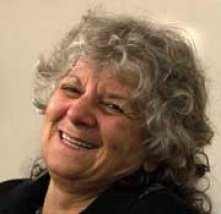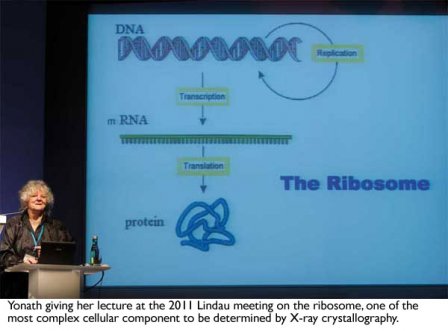Ada Etil Yonath
X-ray crystallographer currently at the Weizmann Institute of Science in Rehovot, Israel. She won a share of the 2009 Nobel Prize in Chemistry for her work on the structure and function of the ribosome. Yonath was born in 1939 in Jerusalem to a poor family. Her father died when she was 11 years old, and Yonath helped support her mother and younger sister. Yonath was the first Israeli woman to win a Nobel prize and the first woman in 45 years to win the Nobel Prize in Chemistry
In your talk at Lindau, you used a lot of analogies and evidence from outside of your scientific work — climbing mountains, or finding inspiration in polar bears. Do you try to keep a broad mind and outside interests?
I don't make any special effort to look for inspiration. I just happened to read about polar bears because I had time to read after having an accident and had to recover. My mind is usually wandering around — I read one thing and think about related subjects. My ideas are always bubbling under the surface and inspiration can strike from any source.
You have spoken openly about your humble beginnings: do you think they helped you develop your inquisitive mind?

I think my difficulties as a child — the poverty and fight for survival — made me stronger. I didn't even know what science was as a child, but I have found that science is a blessing. I can come up with a question and be paid to answer it. Of course the question has to be fundamental and I have to prove that I might be able to do it and show that I'm making progress. In basic science, many problems I come across, even if I can't solve them, I can find a way around them or at least take a different approach to the problems. In life, if you can't help your mother to feed you and your sisters, there are no alternatives. Survival in life gave me a lot of persistence and resistance to keep going and actually solve my problems. And it helped me put things in proportion.
Did these qualities of persistence and resistance help you determine the structure of the ribosome?
I try to emphasize that science is a step-by-step process of making small advances. Not everyone understands that. It's not like one day there was a miracle. In our work, we might have had misgivings, but we also had hints of progress. Each step was harder and harder and brought more problems, but overcoming them was very beneficial, and not just for our work. When my project on the ribosome was in its initial phase, I was pushing the management committee for X-ray synchrotrons to be technically more suitable so that even if we didn't solve the structure of the ribosome, we would at least contribute a lot in terms of improving the technologies available at synchrotrons, both for us and for other scientists.
The complex ribosome structure was a great challenge to crystallize. Is there any limit on the type of structure that can be crystallized?
The ribosome is one of the most difficult structures to have been crystallized. Size isn't the biggest problem in crystallization — although it used to be — it's internal mobility and flexibility: heterogeneity. A ribosome is a complex of about 80 different components that vary according to functional state. But when you do crystallization studies you require one structure. If you have a population of ribosomes that are all in different configurations you will get different 3-dimensional shapes and no periodicity, which you need in crystallography. These are the challenges that are difficult to overcome.
At Lindau, you spoke of the ribosome's ‘ancient core of RNA'. Do you think RNA is more important than DNA in the origins of life?
Yes, definitely: DNA came much later. One aspect of RNA is that it is the thing carrying the information from DNA to be translated into proteins in the ribosome. But RNA is not just an information store as DNA is; in addition to self replication, it can actually do things and make things, such as enzymes to control reactions. DNA cannot do this.
There are many different types of RNA. One type of RNA carries the protein building blocks. And 60% of the ribosome is RNA — the part that decodes the information and makes the proteins. This ribosomal core, which we identified, is an example of a ‘machine' from before life evolved. Life grew around it. RNA was one of the first simple molecules.

Yonath giving her lecture at the 2011 Lindau meeting on the ribosome, one of the most complex cellular component to be determined by X-ray crystallography.
As of 2010, you are one of only 40 women (compared to about 500 men) to have won the Nobel prize. Do you perceive extra pressure to be a scientific role model for young women?
No, I think science is gender-independent. Some people might not think so, because there are problems with equal representation of women in science, but that is not because of the nature of science. The reason why there are not as many women comes from the fact that few women take up jobs to lead groups in labs. This can and should be changed.
Having said that, some people contact me because I am the only woman alive with a chemistry Nobel. They insist that I attend their meeting, which does put a lot of pressure on me. For instance I'm currently in Puerto Rico at the IUPAC World Chemistry Congress; I gave a talk this morning and spoke to the students privately afterwards. Next week I will be the guest of the Chilean students (at the National Commission for Science & Technology), where I will give two lectures: a motivational talk and a scientific talk.
All this attention is enjoyable however, and from the responses I've had I think the students enjoy it too. You can't imagine how excited they are to meet a Nobel laureate. They want to take pictures and get autographs. It is clear that this is their dream, and maybe I got them closer to realizing it.
As a recent laureate, what impact do you hope your Nobel prize will have?
"I'm trying to change the image of scientists, especially of female scientists, so there will not be so many anti-female sentiments."
Very little on my day-to-day work: I am continuing as normal. I have some students that maybe applied to work in my lab because of the prize, which is nice — some from countries like Malaysia, Singapore and China. I'm also directing my efforts to the young generation, showing them that science is not a dull profession, that it's not about being stuck in a lab all day working on a boring project. I'm trying to change the image of scientists, especially of female scientists, so there will not be so many anti-female sentiments. Because there are people in society, particularly parents, who are not necessarily against women studying science but they don't agree with women holding demanding positions while running a household.
What did you learn from your mentors?
I remember on one occasion, I made a little mistake — really just a typo. My supervisor was annoyed and questioned me about it. I apologized for it, said it was a minor error and explained that I had a lot of deadlines. He looked at me and said: "You want to stay in science? Then all your life you will be going from deadline to deadline." He was right.
How do your early career plans compare with your actual career?
When I was young, I chose something else! My thoughts were more about my country and I didn't think about science. I did compulsory military service. I served in the medical corps and worked with doctors, planning a course for other doctors in the field. I learned a lot about medicine and doctors in general. Indirectly, this fed into my work in science. I learned not to give up so fast. Try your best to solve the problem; look for all possibilities.
Conversely: how do you try to mentor your students?
I'm just myself. I don't make any special concessions; I don't change myself. Most of my students seems to like me as I am.
What kind of attitudes and qualities should a young scientist develop?
Be curious — that is most important. Take passion. Be ready to sometimes experience difficulties, but enjoy what you are doing. In other words: be tough, and love your work.
